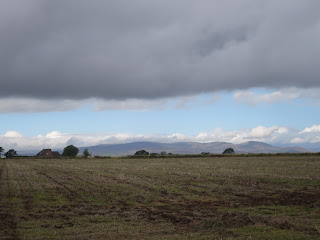History, change, and renewal: a weekend in Scotland, with Ali Bacon
 |
| Angus - farming country in the lee of the hills |
When we do historical research it’s easy to think that we
have to uncover some hidden world lying beneath the accretions of business,
construction, technology and all the stuff that has happened between ‘now’ and
‘then’, stuff we often think of as progress.
But of course things aren’t that simple, and I was reminded
of this last weekend on a bit of an impromptu trip to Scotland to the
small town in Angus which was home to many of my ancestors.
 |
| Brechin High Street |
I had been there
only once before, in my childhood, and had hazy memories of family walks,
paddling in a very cold river, and on rainy days (we had a few!) being allowed
to spend my pocket money in Woolworths. (Retail therapy started young in my case!) Returning after 50 (or more) years, I found (no surprise) that even Woolworths
has gone, leaving a random mixture of businesses: –an upmarket deli and an
unreconstructed corner shop, a local
hardware supplier and a Polish grocer, a small branch of Boots and one of those
wedding boutiques that seem to pop up in small towns. Despite the addition of the Auld
Bakehouse serving posh coffee and cake on the site of a 1950s family bakery,
the effect was curiously inert.
But what did surprise me was the quaintness (unnoticed by my
seven-year-old self) of the old town centre with lots of the 18th
century houses in the street where our
ancestors lived more or less unchanged. It was comparatively easy to picture
their lives there in a sleepy town built around the cathedral where my great-great-grandfather
worked, surrounded by farming country and close to the hills and glens.
 |
| Duke's Mill - old factory, new flats |
But in fact this was also an illusion. From the
mid-nineteenth century Brechin had two linen factories and a paper mill.
Contemporary engravings show a town of smoking chimneys and my Granny worked,
like all of her friends, at Duke’s, a power-loom mill built with enough
Victorian chutzpah to have been preserved today as up-market flats. Local
almanacs provided for us in the library showed the plethora of manufacturers
and retailers attending to the needs of a busy population. Glasgow it was not, but it had all the
hallmarks of Victorian society, a station and a new town square, a floridly
gothic Mechanics Institute and a slum area prone to flooding.
So history is not so much about progress (however we define
it) as change and renewal. When one industry dies (Dukes closed in 1980) what
will take its place? There was new building going on and our landlady claimed
she was busy on week-nights with businessmen en route to and from Aberdeen , but I wonder if
Brechin will be bigger or smaller, busier or more dormant, in another fifty
years. Time marches on, but not always
in the direction we expect.
Last year I read Adam Thorpe's Ulverton, a curious novel that exposes the
life of a community through its landscape, and you could at least say that in Brechin
we can peer through the centuries and imagine the characters who lived and worked
there.
By contrast, on our way home, we had an overnight stop in Edinburgh ’s Western
Harbour
Newhaven was
also made famous by the photographs of my hero and so I couldn’t resist a quick
look at what’s left. To be fair the original village (as seen here) is
now a conservation area and the Victorian school is still in use as council
offices alongside a bright new primary.
A
few streets of new housing have been built in the style of the fishermen’s ‘forestair’
cottages. But for me on the edge of this city with so much history, this tiny
settlement (briefly celebrated in my contemporary novel) has somehow been eclipsed by the world around it. If only its museum (now a wholesale fishmonger) had survived it
might have made more of a mark and call to passers by that there is something
here worth seeing or learning about.
But perhaps not everywhere can wear its history on its
sleeve, and writers will always be happy to dig around and see what lies
beneath.
A Kettle of Fish by Ali Bacon
contemporary Scottish fiction
contemporary Scottish fiction
available as e-book or paperback
She’s running as fast as she can, but the past is catching up.
Ailsa has just left school and should be living it up on a summer trip, but her plans are scuppered by her needy and secretive mother Lorraine. In desperation she takes up with local fishmonger Ian. He’s good for her soul and her sex-life, but their future is blighted by the shadow of Ailsa’s absent father Tom, an art-teacher who left home after making the papers in the worst possible way. Ian eventually blots his copy book and Lorraine is implicated in his treachery. Ailsa takes off for Edinburgh where Shane, a picture rights dealer with more than a touch of the night, is happy to provide a job and a bed. With him Ailsa lets go of her inhibitions, but can she let go of her past?
A Kettle of Fish moves from the East coast of Fife to the art galleries of Edinburgh, where Ailsa finds herself fishing for clues about Tom.



Comments
Good post Ali, it brought back memories of Brechin when it was a thriving small town, although I should actually say'city' because it is a Cathedral City.
Now funny you should say that re the cathedral, because I was aghast when Pointless did not allow Brechin as a city - using some new criteria I suppose!